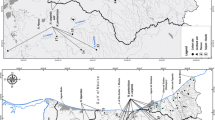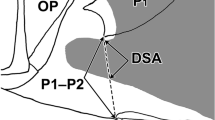Abstract
Taxonomic analysis of a group of morphologically similar and phylogenetically related ponyfishes (Perciformes: Leiognathidae) establishes the Equulites elongatus species group comprising three valid species: Equulites aethopos sp. nov., currently known only from southern Red Sea; Equulites elongatus (Günther 1874), known from northern Australia, Indonesia and Myanmar; and Equulites popei (Whitley 1932), known from Japan, Philippines, Malaysia (Sabah), Thailand (Gulf of Thailand), Oman, the Red Sea, and Mozambique. Although E. popei has previously been regarded as a junior synonym of E. elongatus, the present mitochondrial DNA analysis revealed that these two nominal species are different and that they constitute a monophyletic group separate from other species of Equulites. The E. elongatus species group can be defined by the following of characters: slender body (20–30% in standard length), deeply incised posterior margin of the adipose eyelid, and ventral surface of breast completely scaly. Equulites aethopos sp. nov. differs from the other two species in having smaller eyes (eye diameter 53–68% of postorbital head length vs. 78–137%) and tips of neural and hemal spines of the fourth preural centrum distinctly expanding (vs. slightly expanding). Equulites elongatus is distinguished from E. popei by: scales above and below the lateral line 5–9 and 9–14, respectively (vs. 8–13 and 12–19), anus anteriorly located (distance from the pelvic-fin insertion to the center of anus 30–42% of the distance from the pelvic-fin insertion to the anal-fin origin vs. 35–50%), and more numerous dorsolateral dark marks (1–9 ring marks and 0–14 dark spots smaller than a half of pupil diameter vs. 0–2 and 0–5).








Similar content being viewed by others
References
Bauchot M-L, Desoutter M (1989) Catalogue critique des types de poissons du Museum national d’Histoire naturelle. (Suite). Sous-ordre des Percoidei. Familles des Aplodactylidae, Apolectidae, Arripidae, Cepolidae, Cheilodactylidae, Chironemidae, Cirrhitidae, Echenieidae, Enoplosidae, Embiotocidae, Gerreidae, Lactariidae, Latrididae, Leiognathidae, Loboitidae, Malacanthidae, Menidae, Nandidae, Oplegnathidae, Owstoniidae, Pomatomidae et Rachycentridae. Bull Mus Natl Hist Nat Ser 4 Sect A 11(2) suppl:1–58
Bleeker P (1851) Over eenige nieuwe geslachten en soorten van Makreelachtige visschen van den Indischen Archipel. Natuurkd Tijdschr Neder Indië 1:341–372
Chakrabarty P, Chu J, Nahar L, Sparks JS (2010) Geometric morphometrics uncovers a new species of ponyfish (Teleostei: Leiognathidae: Equulites), with comments on the taxonomic status of Equula berbis Valenciennes. Zootaxa 2427:15–24
Chakrabarty P, Davis MP, Smith WL, Berquist R, Gledhill K, Frank L, Sparks JS (2011) Evolution of the light organ system in ponyfishes (Teleostei: Leiognathidae). J Morph 272:704–721
Cuvier GL, Valenciennes A (1835) Histoire naturelle des poisons, vol 10. Chez FG Levrault, Paris
Dunlap PV, McFall-Ngai MJ (1984) Leiognathus elongatus (Perciformes: Leiognathidae): two distinct species based on morphological and light organ characters. Copeia 1984:884–892
Eschmeyer WN, Fricke R, van der Laan R, eds (2016). Catalog of fishes: genera, species, references. On line version, updated 1 Nov. 2016. http://researcharchive.calacademy.org/research/ichthyology/catalog/fishcatmain.asp. Accessed 22 Nov. 2016
Evermann BW, Seale A (1907) Fishes of the Philippine Islands. Bull Bur Fish 26:49–110
Fowler HW (1904) A collection of fishes from Sumatra. J Acad Nat Sci Philad (Ser 2) 12:495–560
Fricke R (1999) Fishes of the Mascarene Islands (Rèunion, Mauritius, Rodriguez). An annotated checklist with descriptions of new species. Koeltz, Königstein
Fricke R, Eschmeyer WN (2015) A guide to fish collections in the Catalog of fishes. Online version, updated 2 Nov. 2015. Internet publication, California Academy of Sciences, San Francisco. http://research.calacademy.org/research/Ichthyology/Catalog/collections.asp. Accessed 9 November 2015
Gloerfelt-Tarp T, Kailola PJ (1984) Trawled fishes of southern Indonesia and northwestern Australia. Australian Development Assistance Bureau (ADAB), Directorate General of Fisheries, Indonesia (DGF) and German Agency for Technical Cooperation (GTZ)
Golani D, Fricke R, Appelbaum-Golani B (2011) First record of the Indo-Pacific slender ponyfish Equulites elongatus (Günther, 1874) (Perciformes: Leiognathidae) in the Mediterranean. Aquat Invasions 6:75–77
Günther A (1860) Catalogue of the acanthopterygian fishes in the collection of the British Museum. 2. Squamipinnes, Cirrhitidae, Triglidae, Trachinidae, Sciaenidae, Polynemidae, Sphyraenidae, Trichiuridae, Scombridae, Carangidae, Xiphiidae. British Museum, London
Günther A (1874) Descriptions of new species of fishes in the British Museum. Ann Mag Nat Hist (Ser 4) 14:368–371
Hubbs CL, Lagler KF (1947) Fishes of the Great Lakes region. Bull Cranbrook Inst Sci 26:1–186
ICZN (1999) International code of zoological nomenclature, 4th edn. The International Trust for Zoological Nomenclature, London
James PSBR (1978) A systematic review of the fishes of the family Leiognathidae. J Mar Biol Assoc Ind 17:138–172
Jawad LA, Al-Mamry JM, Al-Mamary, DS, Al-Rasady EH (2012) First record of the slender ponyfish, Equulites elongatus (Günther, 1874) (Family: Leiognathidae) from the coasts of Muscat City at the Sea of Oman, Sultanate of Oman. J Appl Ichthyol 2012:1–4
Jones G (1985) Revision of the Australian species of the fish family Leiognathidae. Aust Mar Freshw Res 36:559–613
Jordan DS, Tanaka S, Snyder JO (1913) A catalogue of the fishes of Japan. J Coll Sci, Imp Univ Tokyo 33:1–497
Kimura S (2009) Leiognathidae. In: Kimura S, Satapoomin U, Matsuura K (eds) Fishes of Andaman Sea, west coast of southern Thailand. National Museum of Nature and Science, Tokyo, pp 128–134
Kimura S, Dunlap PV, Peristiwady T, Lavilla-Pitogo R (2003) The Leiognathus aureus complex (Perciformes: Leiognathidae) with the description of a new species. Ichthyol Res 50:221–232
Kimura S, Motomura H, Iwatsuki Y (2008) Equulites Fowler 1904, a senior synonym of Photoplagios Sparks, Dunlap, and Smith 2005 (Perciformes: Leiognathidae). Ichthyol Res 55:204–205
Kuiter RH, Tonozuka T (2001) Pictorial Guide to Indonesian Reef Fishes. Zoonetics, Seaford
Kurogi H (2008) Study on the inshore migration mechanism of Conger myriaster leptocephali. Bull Fish Res Agen 24:105–152
Lacepède BGE (1803) Histoire naturelle des poisons, vol 5. Plasson, Paris
Lindberg GU, Krasyukova ZV (1971) Fishes of the Sea of Japan and of adjacent areas of the Sea of Okhotsk and the Yellow Seas. Part 3. Teleostomi XXIX Perciformes Percoidei (XC Serranidae–CXLIV Champsodontidae. Izdatel’stvo “Nauka” Leningradskoe Otdelenie, Leningrad
Matsubara K (1963) Fish Morphology and Hierarchy, Second Edition. Ishizaki-shoten, Tokyo
Miya M, Nishida M (2000) Use of mitogenomic information in teleostean molecular phylogenetics: a tree-based exploration under the maximum-parsimony optimality criterion. Mol Phylogenet Evol 17:437–455
Mohsin AKM, Ambak MA (1996) Marine fishes and fisheries of Malaysia and neighbouring countries. Universiti Pertanian Malaysia Press, Serdang
Okada Y, Matsubara K (1938) Keys to the fishes and fish-like animals of Japan. Including Kuril Islands, southern Sakhalin, Bonin Islands, Ryukyu Islands, Korea and Formosa. Sanseido, Tokyo and Osaka
Ra H-K, Choi Y, Lim H-C (2005) Taxonomic review of the genus Leiognathus (Perciformes) from Korea. Korean J Ichthyol 17:91–97
Rau N, Rau A (1980) Commercial Marine Fishes of the Central Philippines (Bony Fishes). German Agency for Technical Cooperation, Eschborn
Sainsbury KJ, Kailola PK, Leyland GG (1984) Continental shelf fishes of northern and north-western Australia. Commonwealth of Australia, Canberra
Sasaki A, Ikejima K, Aoki S, Azuma N, Kashimura N, Wada M (2003) Field evidence for bioluminescent signaling in the pony fish, Leiognathus elongatus. Environ Biol Fishes 66:307–311
Senou H (2002) Leiognathidae. In: Nakabo T (ed) Fishes of Japan with pictorial keys to the species, English edition. Tokai University Press, Tokyo, pp 809–812
Senou H, Matsuura K, Shinohara G (2006) Checklist of fishes in the Sagami Sea with zoogeographical comments on shallow water fishes occurring along the coastlines under the influence of the Kuroshio Current. Mem Natl Sci Mus Tokyo 41:389–542
Smith HM, Pope TEB (1906) List of fishes collected in Japan in 1903, with descriptions of new genera and species. Proc US Nat Mus 31:459–499
Sparks JS (2006) A new species of ponyfish (Teleostei: Leiognathidae: Photoplagios) from Madagascar, with a phylogeny for Photoplagios and comments on the status of Equula lineolata Valenciennes. Am Mus Novit 3526:1–20
Sparks JS, Chakrabarty P (2007) A new species of ponyfish (Teleostei: Leiognathidae: Photoplagios) from the Philippines. Copeia 2007:622–629
Sparks JS, Chakrabarty P (2015) Description of a new genus of ponyfishes (Teleostei: Leiognathidae), with a review of the current generic-level composition of the family. Zootaxa 3947:181–190
Sparks JS, Dunlap PV, Smith WL (2005) Evolution and diversification of a sexually dimorphic luminescent system in ponyfishes (Teleostei: Leiognathidae), including diagnoses for two new genera. Cladistics 21:305–327
Stamatakis A (2006) RAxML-VI-HPC: maximum likelihood-based phylogenetic analysis with thousands of taxa and mixed models. Bioinformatics 22:2688–2690
Steindachner F (1898) Über einige neue Fischarten aus dem rothen Meere. Anz Akad Wiss Wien 35:198–200
Temminck CJ, Schlegel H (1845) Pisces, Fauna Japonica, sive descriptio animalium quae in itinere per Japoniam suscepto annis 1823–30 collegit, notis observationibus et adumbrationibus illustravit. Parts 7–9:113–172, pls 1–143
Uyeno T, Yabumoto Y (1984) Leiognathidae. In: Masuda H, Amaoka K, Araga C, Uyeno T, Yoshino T (eds) The fishes of the Japanese Archipelago. Tokai University Press, Tokyo, pp 153–154, pl 143
Ward RD, Zemlak TS, Innes BH, Last PR, Hebert PDN (2005) DNA barcoding Australia’s fish species. Phil Trans R Soc B Bio Sci 360:1847–1857
Weber M, de Beaufort LF (1931) The fishes of the Indo-Australian Archipelago. VI. Perciformes (continued) Families: Serranidae, Theraponidae, Sillaginidae, Emmelichthyidae, Bathyclupeidae, Coryphaenidae, Carangidae, Rachycentridae, Pomatomidae, Lactariidae, Menidae, Leiognathidae, Mullidae with 81 illustrations. E J Brill, Leiden
Whitley GP (1932) Some fishes of the family Leiognathidae. Mem Qld Mus 10:99–116
Woodland DJ, Premchaoen S, Cabanban AS (2001) Leiognathidae. In: Carpenter KE, Niem VH (eds) FAO species identification guide for fishery purposes. The living marine resources of the Western Central Pacific, vol 5, bony fishes part 3 (Menidae to Pomacentridae). FAO, Rome, pp 2792–2823
Zheng W-L (1962) Leiognathidae. In: Institute Zoologica Academia Sinica, Institute Oceanology Academia Sinica, Shanghai Fish Collection (eds) The fishes of South China Sea. Science Press, Beijing, pp 438–455
Acknowledgements
We are most grateful to the following persons and institutions for the loan or donation of specimens: M. McGrouther and S. Reader (AMS); J. Maclaine (BMNH); A. Graham (CSIRO); P. Psomadakis (Food and Agriculture Organization of the United Nations); D. Golani (HUJ); T. Peristiwady (Indonesian Institute of Sciences); H. Motomura (KAUM); H. Senou (KPM); G. Duhamel, P. Pruvost and R. Causse (MNHN); Y. Iwatsuki (MUFS); L. A. Jawad (New Zealand); E. Mikschi and H. Wellendorf (NMW); K. Matsuura, G. Shinohara and M. Nakae (NSMT); Y. Sakurai (Okinawa Environmental Research Co., Ltd); U. Satapoomin (formerly of PMBC); P. Heemstra and E. Heemstra (SAIAB); A. B. Arshad (Universiti Putra Malaysia); J. T. Williams and S. Raredon (USNM); S. Morrison (WAM); M. Hayashi and K. Hagiwara (YCM). We thank the students of FRLM, especially Y. Hibino and R. Matsuo, for their cooperation in field collections, D. Sasaki and S. Takeuchi (formerly of FRLM) for advice on molecular analysis, I. Kobayashi and staff of the Life Science Research Center, Center for Molecular Biology and Genetics (Mie University), for nucleotide sequences, and P. V. Dunlap (University of Michigan) for his critical comments on a draft of the manuscript and his assistance with English. This study was supported in part by JSPS (Japan Society for the Promotion of Science) KAKENHI Grant Numbers 23570114 and 16K07840 awarded to the second author, and by the Asian Core Program and the Core-to-Core Program (CCore-RENSEA) of JSPS.
Author information
Authors and Affiliations
Corresponding author
Additional information
This article was registered in the Official Register of Zoological Nomenclature (ZooBank) as 4F679BA9-97C6-4B90-BDFE-33FD5980447D.
This article was published as an Online First article on the online publication date shown on this page. The article should be cited by using the doi number.
About this article
Cite this article
Suzuki, H., Kimura, S. Taxonomic revision of the Equulites elongatus (Günther 1874) species group (Perciformes: Leiognathidae) with the description of a new species. Ichthyol Res 64, 339–352 (2017). https://doi.org/10.1007/s10228-017-0572-9
Received:
Revised:
Accepted:
Published:
Issue Date:
DOI: https://doi.org/10.1007/s10228-017-0572-9




